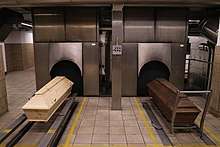
Memorial Gardens at Carmountside Cemetery, Stoke on Trent where cremated ashes are spread

An electric cremator in Austria

Cremation is becoming increasingly the rule

The most hygienic way to dispense with the body is cremation
Cremation involves the combustion or burning of cadavers into ashes, an environmentally sound and frugal alternative to traditional burial.
Quotes
- It is a fortunate and happy thing that... Before so very long, burial in the ground will be against the law, and cremation will be enforced, and this as a health and sanitation measure. Those unhealthy, psychic spots, called cemeteries, will eventually disappear, just as ancestor worship is passing out, both in the Orient – with its ancestor cults – and in the Occident – with its equally foolish cult of hereditary position. p. 55
- These taints to which humanity is prone, are found in the soil, and their presence there is largely due to burial, down the ages, of millions of corpses. By the increased use of the processes of cremation, this condition will be steadily improved. Gradually, very gradually, the taint will thus die out... As the soil becomes less tainted... we can hope to see a steady decrease in the number of those who succumb to the inherited taints. p. 61/2
- Alice Bailey in Esoteric Healing, (1953)
- Much good will be brought about through the growing custom to cremate those forms which the indwelling life has vacated; when it is an universal custom, we shall see a definite minimising of disease, leading to longevity and increased vitality. p. 249
- If delay is necessary from family feeling or municipal requirements, cremation should follow death within thirty-six hours; where no reason for delay exists, cremation can be rightly permitted in twelve hours. It is wise, however, to wait twelve hours in order to ensure true death. p.485
- Alice Bailey in Esoteric Healing, (1953)
- If the dense body be buried, the etheric double floats over the grave, slowly disintegrating, and the unpleasant feelings many experience in a churchyard are largely due to the presence of these decaying etheric corpses. If the body is burned, the etheric double breaks up quickly, having lost its nidus, its physical centre of attraction, and this is one among many reasons why cremation is preferable to burial, as a way of disposing of corpses.
- Back in 1980, less than 5 percent of Americans were cremated when they died. That figure now stands at about 50 percent... Rosehill charges just $180 to cremate a body, although the urn, flowers, and service are extra. A grave, by contrast, can cost $2,500, plus an additional $1,500 to open the ground with a backhoe.
- Caren Chesler in [https://www.popularmechanics.com/science/health/a18923323/cremation/ Burning Out: What Really Happens inside a Crematorium, Popular Mechanics (1 March 2018)
- The only scientific and hygienic way to dispense with the body is cremation, to burn it....Through the practice of burial...illnesses, like cancer, syphilis and tuberculosis, are leached out into the earth, enter the food chain and are reabsorbed by animals and humans alike. This has gone on for so many thousands of years that these illnesses are endemic and will take several hundreds of years to overcome completely. Cremation is a first, major step in this process.
- The funeral industry is a $16 billion a year industry...The average cost of a funeral is about $7,200... Direct cremation, meaning no viewing or ceremony, is the cheapest option, at just over $2,000. There are more details breaking down what the different parts of the funeral cost at the NFDA website. Forty-five percent of those who died in 2015 were cremated in 2015... projected to be 70 percent by 2030.
- Shane Ferro in Things You Didn’t Know About The Industry Of Death, Huffington Post (10 January 2016)
- By far the most effective, hygienic, and also the 'neatest' way of disposing of... [our] physical remains is by cremation. ...Burial in Mother Earth.. is most unhygienic because so many deaths are caused by infectious diseases, and in burying these corpses the soil becomes contaminated by the causal germs and viruses, which may remain contagious for many years. Thus the burial of millions of the infected corpses has contaminated large parts of the Earth's surface.
- It’s estimated that each year, at least 20,000 people donate their whole body, after death, to medical facilities throughout the country to be used in medical research projects, anatomy lessons and surgical practice. After using your body, these facilities will then provide free cremation... and will either bury or scatter your ashes in a local cemetery or return them to your family, usually within a year or two.
- Jim T. Miller in A Cheap Death: How to Donate Your Body to Science, Huffington Post (02 October 2017)
- Post-cremation burials have been discovered ... distributed among strata of all periods [at Mohenjo Daro.]
See also
External links
This article is issued from
Wikiquote.
The text is licensed under Creative
Commons - Attribution - Sharealike.
Additional terms may apply for the media files.